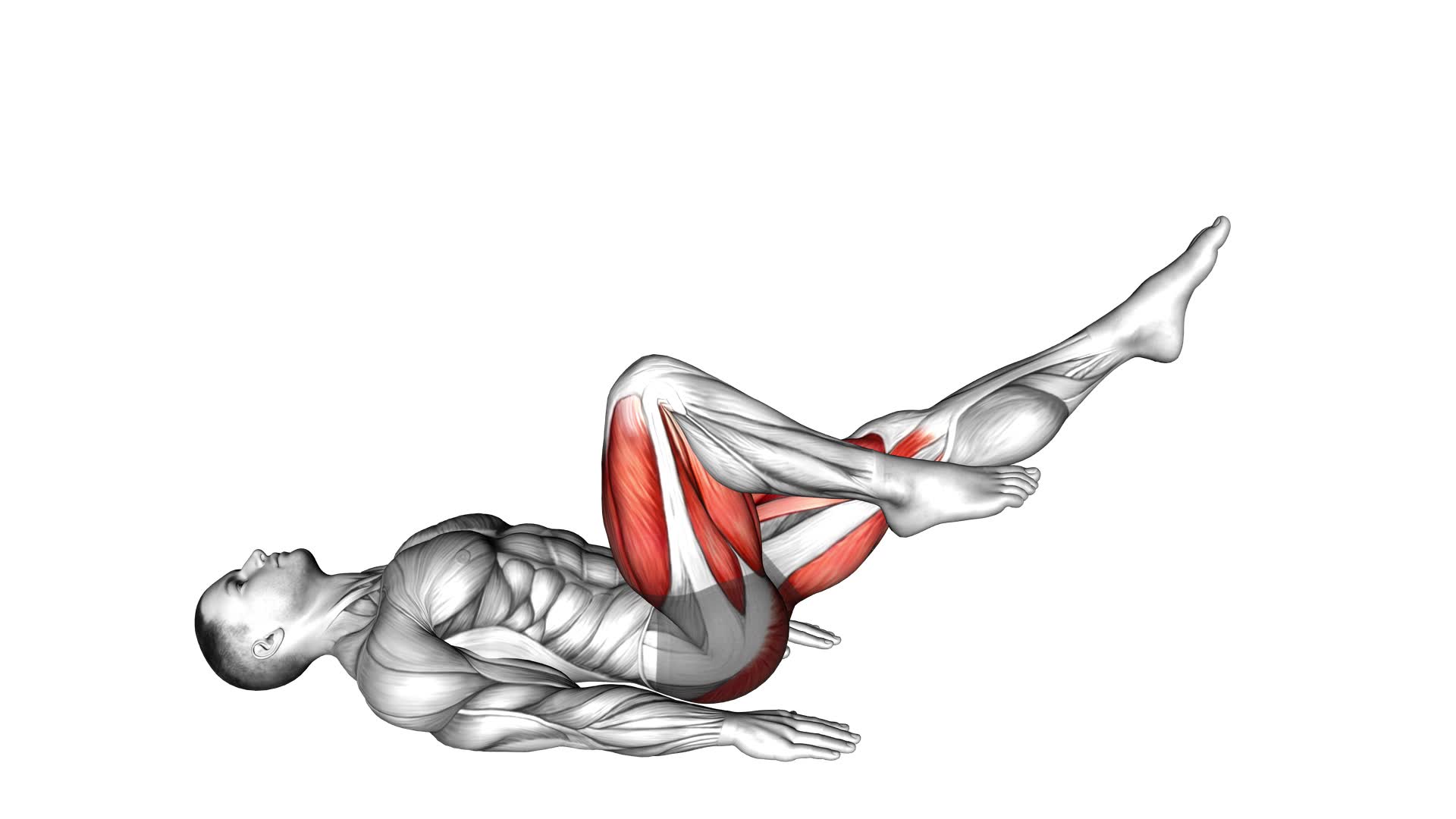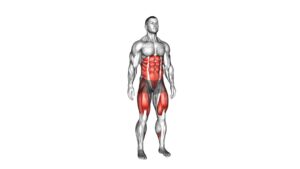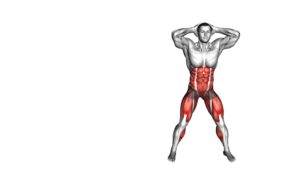Lying Air Cycles – Video Exercise Guide & Tips

In this video exercise guide, you'll discover the benefits of lying air cycles and how to perform them correctly.
Watch This Exercise Video
With just a few pieces of equipment, you can engage your core and strengthen your abdominal muscles.
Avoid common mistakes and maximize your results by following these tips.
Get ready to feel the burn and take your fitness routine to the next level with lying air cycles.
Let's get started!
Key Takeaways
- Lying Air Cycles provide a low-impact workout for legs and core muscles.
- Proper form and technique, such as engaging core muscles and maintaining alignment, are crucial for maximum core engagement.
- Additional tools like ankle weights or resistance bands can increase the intensity and engage leg and core muscles.
- Controlled breathing patterns and coordination with movements help stabilize the body and optimize performance.
Benefits of Lying Air Cycles
One benefit of lying air cycles is that they provide a low-impact workout for your legs and core muscles. This exercise is an excellent choice for those who want to strengthen their lower body without putting too much stress on their joints. Lying air cycles variations and modifications can be done to cater to different fitness levels and goals.
By performing lying air cycles, you engage your leg muscles, including your quadriceps, hamstrings, and calves. Additionally, your core muscles, such as your abdominals and lower back, are also activated to maintain stability throughout the exercise. This helps improve your overall balance and stability.
Lying air cycles can be modified by adjusting the intensity and range of motion. For beginners or individuals with limited mobility, you can start by performing smaller leg movements with less resistance. As you build strength and flexibility, you can gradually increase the range of motion and resistance to challenge yourself.
In the next section, we'll discuss the equipment needed for lying air cycles to ensure you have everything you need to perform this exercise.
Equipment Needed for Lying Air Cycles
To perform lying air cycles, you'll need a few pieces of equipment. The main item you'll need is an exercise mat or a comfortable surface to lie on. This will provide cushioning and support for your body during the exercise. Additionally, you may want to use a small towel or pillow to support your head and neck.
While lying air cycles primarily focus on core activation and muscle engagement, you don't need any specific equipment to target these areas. The exercise is performed by lying on your back with your legs extended and your hands placed underneath your lower back for support. From this position, you'll engage your core muscles and lift your legs off the ground, cycling them in a controlled and deliberate motion.
It's important to note that while equipment isn't necessary for lying air cycles, it can be beneficial to use additional tools such as ankle weights or resistance bands to increase the challenge and intensity of the exercise. These can help to further engage the muscles of the legs and core, leading to greater strength and toning benefits.
Proper Form and Technique for Lying Air Cycles
To perform lying air cycles with proper form and technique, there are a few key points to keep in mind.
First, focus on engaging your core muscles throughout the exercise to maintain stability and control.
Second, be mindful of your breathing, inhaling deeply as you extend your legs and exhaling as you bring them back in.
Finally, be aware of common form mistakes such as arching your back or using momentum to complete the movement.
Core Engagement Tips
Engage your core by maintaining proper form and technique during lying air cycles. Core activation is crucial for stability and effective execution of this exercise. To ensure proper engagement, start by lying flat on your back with your legs extended and your arms by your sides.
As you lift your legs off the ground and begin the cycling motion, focus on pulling your belly button towards your spine to activate your deep core muscles. Keep your lower back pressed firmly against the floor to maintain core stability throughout the movement.
Avoid overarching or lifting your shoulders off the ground, as this can disengage the core. By maintaining proper form and technique, you'll maximize the benefits of lying air cycles and effectively strengthen your core muscles.
Breathing During Exercise
As you perform lying air cycles, it's important to focus on your breathing to maintain proper form and technique. Proper breathing techniques can enhance your exercise performance and maximize oxygen intake.
During lying air cycles, take a deep breath in as you lower your legs towards the ground, and exhale as you bring your legs back up. This controlled breathing pattern helps engage your core muscles and stabilize your body throughout the exercise.
It also ensures a steady flow of oxygen to your muscles, providing them with the necessary fuel for optimal performance. Remember to inhale and exhale deeply, allowing your breath to guide your movements and maintain a steady rhythm.
Common Form Mistakes
Avoid these common form mistakes to ensure proper form and technique while performing lying air cycles.
- First, focus on core activation throughout the exercise. Engage your abdominal muscles by drawing your belly button towards your spine. This will help stabilize your body and prevent any unnecessary strain on your lower back.
- Second, pay attention to your body alignment. Keep your neck and spine in a neutral position, with your lower back pressed against the floor. Avoid arching your back or lifting your shoulders off the ground.
- Lastly, maintain a controlled and steady pace throughout the movement, avoiding any jerky or rushed motions.
Variations and Modifications for Lying Air Cycles
To add variety and challenge to your lying air cycles, incorporate different modifications and variations. By making small adjustments to the exercise, you can target different muscle groups and increase the difficulty level.
One variation you can try is the bicycle crunch. Instead of simply cycling your legs in the air, you can also bring your opposite elbow towards your knee as you cycle. This engages your obliques and adds an extra twist to the exercise.
Another modification is to add weights to your ankles. This increases the resistance and makes your muscles work harder. You can start with light ankle weights and gradually increase the weight as you get stronger.
Additionally, you can perform the lying air cycles on an exercise ball. This challenges your stability and engages your core muscles even more.
Remember to maintain proper form and control throughout the exercise, regardless of the variation or modification you choose.
Incorporating these variations and modifications into your lying air cycles will help you avoid plateaus and continue making progress.
Common Mistakes to Avoid During Lying Air Cycles
To ensure proper form during lying air cycles, focus on techniques such as:
- Keeping your lower back pressed against the ground
- Keeping your core engaged throughout the movement
Remember to:
- Breathe steadily and deeply to maintain control
- Prevent tension in your neck and shoulders
Lastly, avoid:
- Using excessive momentum
- Move slowly and deliberately
- Allow your muscles to do the work rather than relying on momentum to complete the exercise.
Proper Form Techniques
Maintain proper form during lying air cycles by focusing on your core engagement and fluid motion.
Proper core activation is crucial to ensure that you're targeting the right muscles and maximizing the effectiveness of the exercise. To engage your core, imagine pulling your belly button in towards your spine and keeping your abdominal muscles tight throughout the movement.
Additionally, pay attention to your body alignment. Keep your back flat against the mat and your neck relaxed. Avoid arching your back or straining your neck, as this can lead to discomfort or injury.
By maintaining proper form and alignment, you'll be able to perform lying air cycles with efficiency and minimize the risk of strain or injury.
Now, let's move on to the next section about breathing and core engagement.
Breathing and Core Engagement
To ensure proper breathing and core engagement during lying air cycles, focus on coordinating your breath with each movement and actively engage your abdominal muscles. Core stability is key to maintaining proper form and maximizing the effectiveness of this exercise.
As you lift your legs and cycle them in the air, inhale deeply through your nose and allow your diaphragm to expand. Exhale through your mouth as you bring your legs back down to the starting position. This diaphragmatic breathing technique helps engage your deep core muscles and promotes stability throughout the exercise.
Avoid shallow breathing or holding your breath, as this can lead to tension and limit the activation of your core. Remember to maintain a steady, controlled pace and keep your core engaged throughout the entire movement.
Avoiding Excessive Momentum
How can you prevent excessive momentum while performing lying air cycles?
To avoid jerky movements and maintain control, it's important to focus on proper form and technique.
Start by lying flat on your back with your legs extended and your hands by your sides. Engage your core muscles and lift your legs off the ground, keeping them straight.
Slowly begin to cycle your legs in a smooth and controlled motion, as if you're pedaling a bicycle. Avoid swinging your legs too forcefully or using momentum to complete the movement.
Instead, concentrate on engaging your abdominal muscles and maintaining a steady pace. By doing so, you can prevent excessive momentum and ensure a more effective and safe workout.
Tips for Getting the Most Out of Lying Air Cycles
Get the most out of your lying air cycles by focusing on proper form and engaging your core muscles throughout the exercise. Core activation is crucial for maximizing the effectiveness of this exercise. As you perform the lying air cycles, make sure to keep your core muscles engaged by pulling your belly button towards your spine. This will help stabilize your body and prevent excessive strain on your lower back.
Another important tip for getting the most out of lying air cycles is to control the tempo of your movements. Avoid rushing through the exercise and instead, focus on maintaining a slow and controlled pace. This will allow you to fully engage your core muscles and ensure that you're performing the exercise correctly.
Additionally, pay attention to your breathing throughout the exercise. Exhale as you extend your legs and inhale as you bring them back towards your chest. This will help you maintain proper form and control your movements.
Lastly, listen to your body and adjust the intensity of the exercise as needed. If you find that your lower back is experiencing excessive strain, decrease the range of motion or limit the number of repetitions. Remember, it's important to prioritize safety and proper form over quantity.
Frequently Asked Questions
How Many Calories Can I Burn by Doing Lying Air Cycles?
You can burn a significant amount of calories by doing lying air cycles. This exercise targets your abs, glutes, and legs while also providing cardiovascular benefits.
The number of calories burned depends on factors like your weight, intensity, and duration of the workout. To increase calorie burning, you can try variations and modifications of the exercise, such as adding resistance or increasing the speed.
Remember to consult a fitness professional for personalized advice.
Can Lying Air Cycles Help Me Lose Belly Fat?
Lying air cycles are a great exercise for overall fitness and can contribute to losing belly fat. By engaging your core muscles and increasing your heart rate, lying air cycles help burn calories, including those stored in the belly area.
To maximize the benefits, it's important to maintain proper form and technique. Keep your lower back pressed against the ground and focus on controlled movements. Remember to consult with a fitness professional for personalized advice and guidance.
Can Lying Air Cycles Be Done by Beginners?
Yes, lying air cycles can be done by beginners. They're a great exercise for building core strength and can be modified to suit your fitness level.
Incorporating lying air cycles into your workout routine can help you develop a strong and stable core. By engaging your abdominal muscles and performing controlled movements, you can strengthen your core and improve your overall fitness.
Beginners can start with modified versions and progress as they become more comfortable and confident.
Are There Any Alternative Exercises That Target the Same Muscle Groups as Lying Air Cycles?
There are alternative exercises that target the same muscle groups as lying air cycles.
Plank variations are a great option, as they engage your core muscles and promote stability.
Seated bicycle crunches are another effective exercise that also work your abdominal muscles.
These exercises provide similar benefits to lying air cycles and can be done by beginners.
Adding these exercises to your routine will help you strengthen your core and improve your overall fitness.
How Often Should I Incorporate Lying Air Cycles Into My Workout Routine?
To get the most out of lying air cycles, it's important to know how often to incorporate them into your workout routine.
Lying air cycles offer numerous benefits, such as targeting your abdominal muscles and improving core strength.
To maintain proper form, make sure to keep your lower back pressed into the floor and engage your core throughout the exercise.
Incorporate lying air cycles into your routine two to three times a week for optimal results.
Conclusion
Lying air cycles are a beneficial exercise for strengthening and toning the abdominal muscles. By engaging the core and performing the movements correctly, you can maximize the effectiveness of this exercise.
Remember to use the appropriate equipment and avoid common mistakes to ensure proper form. By following these tips and variations, you can get the most out of your lying air cycles and achieve your fitness goals.

Author
Years ago, the spark of my life’s passion ignited in my mind the moment I stepped into the local gym for the first time. The inaugural bead of perspiration, the initial endeavor, the very first surge of endorphins, and a sense of pride that washed over me post-workout marked the beginning of my deep-seated interest in strength sports, fitness, and sports nutrition. This very curiosity blossomed rapidly into a profound fascination, propelling me to earn a Master’s degree in Physical Education from the Academy of Physical Education in Krakow, followed by a Sports Manager diploma from the Jagiellonian University. My journey of growth led me to gain more specialized qualifications, such as being a certified personal trainer with a focus on sports dietetics, a lifeguard, and an instructor for wellness and corrective gymnastics. Theoretical knowledge paired seamlessly with practical experience, reinforcing my belief that the transformation of individuals under my guidance was also a reflection of my personal growth. This belief holds true even today. Each day, I strive to push the boundaries and explore new realms. These realms gently elevate me to greater heights. The unique combination of passion for my field and the continuous quest for growth fuels my drive to break new ground.



